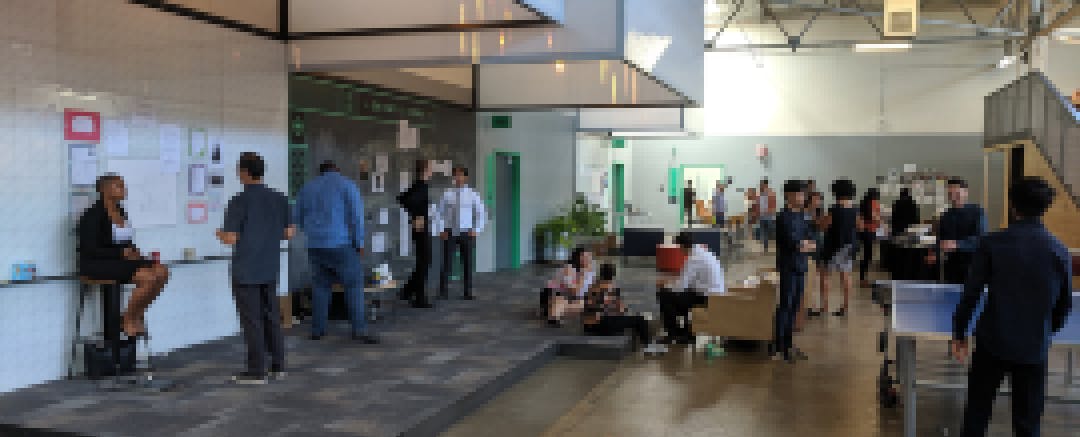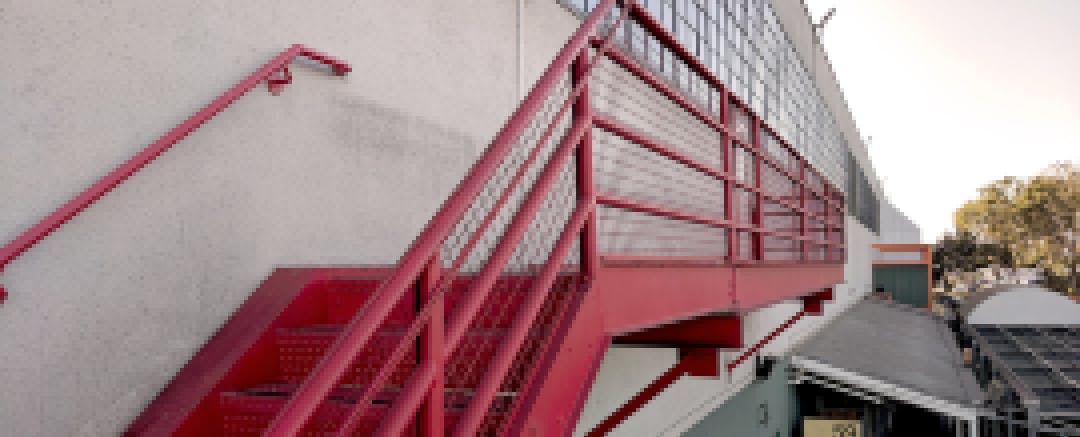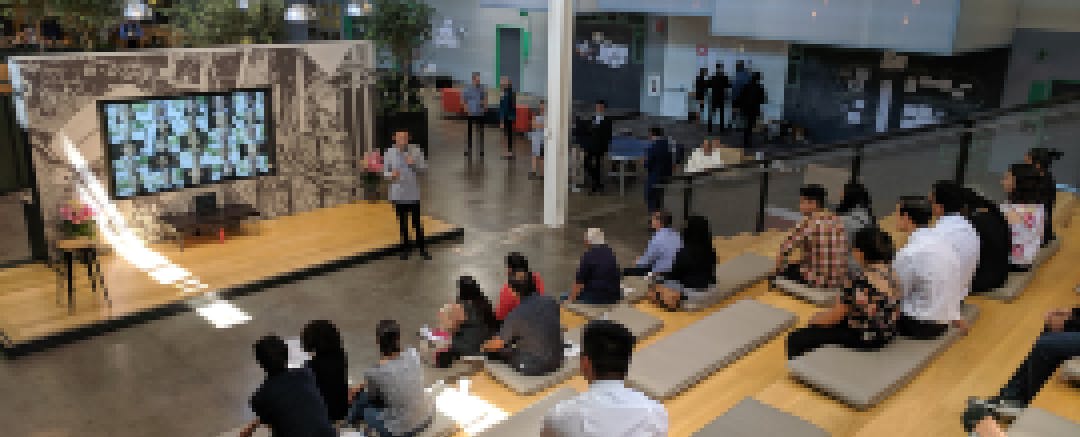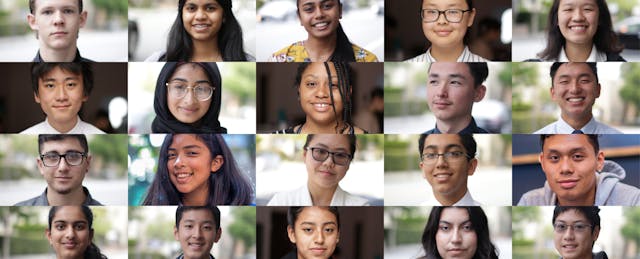SAN LEANDRO, Calif. — A red staircase next to a Home Depot in an ordinary strip mall leads to an equally nondescript door. Behind it is a surprisingly airy, light-filled atrium. The tall ceilings, roof-top windows, exposed steel beams and air ducts hint at its industrial past.
Built in the 1950s, the space, now called Gate 510, first served as a Plymouth automobile plant. A couple decades later, tractors were assembled here for Caterpillar, the construction machinery company. It was subsequently used as a storage warehouse.
The lower floor has since been converted into a retail shopping center. The top now consists of offices for entrepreneurs who brew coffee and beer, design batteries and drones, and sculpt art for Burning Man—among a motley collection of other activities.
This summer, the space is also hosting more than 40 high school students from across the San Francisco Bay Area. They are part of a summer program organized by PilotCity, a San Leandro-based startup that connects local high school students with regional employers for work-based projects and internships.

Today, it is “Pin-Up Day,” the halfway point of a six-week summer internship program where students present their business ideas for critique. They have been working with local governments and tech companies to design solutions to problems such as homelessness, water conservation and clean energy. On the walls are diagrams accompanied with explanations of the projects, much like what one might find at a science fair. Some booths feature prototypes of drones and radio-controlled devices.
Just as the former auto plant has been reinvented, today’s event offers a glimpse into Derick Lee’s vision for how cities will evolve, and who will lead that transformation. The PilotCity co-founder describes the company as a “city innovation engine powered by education.” In plainspeak, his point is that as cities change, students should be empowered and prepared to shape their local communities for the future.
Over the past six years, Lee has been testing programs that connect education, workforce and civic engagement opportunities. The hope is that through providing project-based work, kids not only develop job-ready skills, but also a deeper bond to their community. And by planting those seeds, they will return to help their city after they graduate.
“There are two missions with PilotCity,” says Lee. “Right now, we’re providing education programming for career pathway purposes, and focusing on students, teachers and employers. In the future, we want to get all citizens onboard—elected officials, CEOs, police officers, all different citizen types. The whole idea is to create a more connected citizen who is empowered and enabled to bring change to the city.”
It’s a system that Lee wants to scale across the country, to help other cities tap into the local education and business communities to develop their own talent pipeline. But first, he’ll have to figure out how the model will work at home—and how to pay for it.

MANY STARTUPS HAVE A FOUNDING LORE. For Lee, it began with a pair of glasses—or rather, the ones he forgot to bring to an urban planning conference in 2013. That forced him to sit in the front row of a session where he would meet Deborah Acosta, then San Leandro’s chief innovation officer. She described to him the mayor’s plan to create an innovation ecosystem and attract tech talent and startups to the city.
Lee, a San Leandro native who had just graduated from college the year before, was sold on the vision. But he was not sure about the execution. The city, located just south of Oakland, was a recovering manufacturing hub with few startup companies. There is also no local community college or university—an important ingredient in attracting outside businesses.
San Leandro was, in his words, “silently uninteresting,” a “blank and rather bland canvas.”
That description fits many cities across America. But that doesn’t preclude them from developing the local talent to transform their hometowns, says Lee, now 30. “Rarely did I hear much about working with people from within the community to help build the future of the city. What if we can inspire the kids in K-12 schools to become the pipeline of entrepreneurs, who can shape the future of a city that they care about?”
He began by volunteering his time getting nearby companies to create projects and internship opportunities for students at the local high school. Many employers see it as part of their corporate social responsibility to contribute to the community—and a way to spread the word about their work, Lee says.
That effort got a boost in 2014, when the California Department of Education awarded Career Pathways Trust Grants to K-12 and community college districts to support work-based learning and career pathway opportunities for high school students. Of the $500 million awarded across the state, the regions where Lee worked—primarily in the Alameda County Office of Education—received about $45 million, by his estimate.
Those funds have been crucial in supporting the work of PilotCity, which was officially established in 2015. Among its first contracts was with the San Leandro Unified School District, which it helped create an internship program involving 27 students and 18 employers. The company also designed a makerspace for nearby Hayward Unified School District that year.

To date, Lee says PilotCity’s work has reached close to 3,000 students and 100 teachers in 25 schools across 12 districts in the San Francisco Bay Area. Roughly 200 local employers, including Kaiser Permanente, OSISoft, Sony and Typeform, have also participated.
Today there are three main components to PilotCity’s programming. The first is an “externship” where teachers visit a participating company for professional development to learn about its technology and products. Afterward, the teachers and companies co-design a project challenge for students that is relevant to the class subject. The students break up into teams, and over the course of six to eight weeks they propose ideas for the challenge. Representatives from the companies regularly visit the classroom to share feedback on the projects.
For Larry Lavendel, who teaches vocational educational classes at Mt. Eden High School in Hayward, Calif., having professionals provide personal feedback to students is an invaluable part of the experience.
“Being in school is not the real world,” says Lavendel, who has worked with PilotCity since 2018. “This brings the real world into the school. When kids see that adults come in to spend time with them on projects that people on the outside will use, it’s incredibly meaningful not just academically, but psychologically as well.”
Students who are interested in taking their projects further along can apply and interview with the company for a summer internship. Those who are accepted partake in a six-week summer program, like the one currently hosted at Gate 510, where they work more closely with the company to try and bring their ideas to life.
The program is an opportunity to “pair industry with education to provide real experiences and knowledge that students can use in their future,” says Jason Ebner, a career and technical educator at Antioch High School.
Working with Velodyne Lidar, a developer of sensors used for autonomous vehicles, Ebner asked his freshmen engineering class this year to propose ways to deploy the technology. One group devised a way to create an autonomous system of boats to clean up trash in the nearby river delta. “Our students, after learning about advanced technologies, created an idea to tackle a problem that the company did not intend it for,” he adds.

Currently PilotCity charges school districts about $100 for each student participating in the program. Each district will support anywhere from 50 to 400 students at a given time, says Lee, who adds that a typical contract ranges from $5,000 to $15,000.
Most of those dollars come from the Career Pathways Trust Grants that were disbursed four years ago, but that program is sunsetting. In its place is a similar funding initiative, called the K12 Strong Workforce Program, which will allocate $150 million each year to support programs that build career pathways for California high school students.
Lee estimates that PilotCity has received about $700,000 for its work. The immediate plan is to scale the model more widely across northern California, and eventually the whole state.
The grand vision is to take this model across the country, and Lee believes he’ll likely need to raise capital to support that expansion. So far, a lot of the work has been labor intensive, particularly developing relationships with local employers in other regions to get onboard. The team of 10 is building an online portal to help facilitate the matchmaking, scheduling and planning involved between schools and companies. Eventually, the site will serve as a toolkit that future organizers can use to get their own PilotCity programs up and running, wherever they are.
BACK AT PIN-UP DAY, students took a short break before resuming their posts for the final round of review sessions. Shuffling along the stations are adult professionals—among them city officials, including the mayor of San Leandro, and representatives from Google, Sony and Wells Fargo—who offer guidance and poke holes in the projects.
Altogether sixteen projects are on display. Among them are mobile homeless shelters, smart homes for pets, vape alarms for school bathrooms and fare evasion detectors for BART, the local rail service. Drones feature in many of them. DJI, one of the biggest drone companies in the country, has provided devices for some of the teams. One group proposes using them for sidewalk maintenance work; another for traffic intersection safety assessments.
Rahaf Mohammed, a rising junior at American High School in Fremont Unified School District, aims to build a “Garbage Search Engine.” Using drones and Picterra, an AI object detection software, she wants to locate trash hotspots in beaches, parks and other public spaces. This information would help city workers and volunteers collect waste much more efficiently.
Mohammed says she was inspired after reading about the trash that piled up at national parks after the federal government shutdown this past January. Her team has been in touch with a representative at the National Park Service to get feedback on the idea.

Toward the opposite corner of the hall, Evan Morris is presenting an idea for an autonomous shuttle to ferry students between two different high schools in Antioch, Calif. Antioch High School offers electives focused on computer science and ecological tech programs; four miles away, Deer Valley High has programs for business and robotics.
Currently, students are assigned to the school where they live closest to, and it is hard for them to take classes offered by the other, explains Morris, a rising sophomore at Antioch High School. Working with Velodyne Lidar, the sensor maker, the team wants to provide more transit options that allow students to take different classes.
“We want this project to be a reality so that students can get the education they want,” says Morris. “Nowadays, high school is a critical part of starting your career, and if you start doing what you love now, it can make life a lot easier later in college and in work.”
How viable these ideas are remain to be seen. As the reviewers are quick to point out, emerging technologies involving flying drones and self-driving vehicles raise not just logistical challenges, but legal ones as well that are well beyond the control of students.
But feasibility is also besides the point. The heart of the PilotCity workforce incubator is to get kids to come up with a meaningful problem, articulate how technology can address it, and create a plan to solve it in a financially sustainable way.
At the very least, the program provides kids with a chance to get hands on with new technologies—to pique their interest in tools that they could be working with in the future. For Mohammed, she’s learning to fly and control drones—something she’s never done before. Morris giddily beams as he shows off his prototype: a lidar device strapped to a remote-controlled car, which is attached to a computer monitor showing the objects that the lidar can “see.”
More importantly, working closely with employers empowers students to put their creativity and skills to good use, says Antioch educator Ebner. “It’s somebody saying: ‘Your ideas are valid, worth exploring, and something that can greatly enhance the community in which you live.’”


